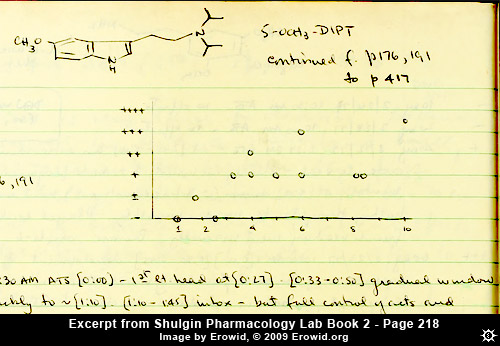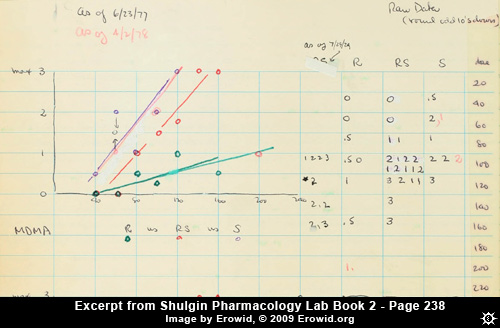Alexander Shulgin's Pharmacology Lab Books
Book 2 Notes
Mar 26, 2009
See Shulgin Lab Books for a brief introduction.

Most of the reports in Lab Book 2 are self-reports of Dr. Shulgin trying substances and determining general activity and dose levels. To view an example, open the PDF (100MB) or view the edited JPEG of page 218, which depicts the type of human data he was collecting at the time. In Book 2, Shulgin recorded the dose information from earlier experiments with 5-MeO-DIPT conducted in 1975 and 1976 (e.g. references to "page 176, 191" refer to entries in Pharmacology Lab Book 1). He then recorded additional trials conducted in 1977. The left axis of the graph excerpted here is the Shulgin Rating Scale and the bottom axis is milligram dosages. The row of circles between 3 mg and 8 mg at the + (plus one) indicate that the material was clearly active, but the character of the effects at those doses was not entirely clear for him, in those trials. On two occasions, at 6.0 and 10.0 milligrams, he did experience strong (+++ to ++++) effects. On the same page (excerpted below), one can read notes about the +++ experience at 10 mg. Note that ATS stands for Alexander T. Shulgin.
 On page 238, Dr. Shulgin collected data about the dose-effects levels for R-isomer, S-isomer, and racemic (RS) formulations of MDMA. Again, he used the Shulgin Rating Scale as a simple way to indicate whether a drug has reached strong effects. After creating both pure stereoisomers of MDMA, he and others tried the materials at a number of doses. By collecting this information, Dr. Shulgin found that the R isomer seemed to be substantially less potent than the S isomer, and also less potent than the racemic mixture that contained both R and S isomers.
On page 238, Dr. Shulgin collected data about the dose-effects levels for R-isomer, S-isomer, and racemic (RS) formulations of MDMA. Again, he used the Shulgin Rating Scale as a simple way to indicate whether a drug has reached strong effects. After creating both pure stereoisomers of MDMA, he and others tried the materials at a number of doses. By collecting this information, Dr. Shulgin found that the R isomer seemed to be substantially less potent than the S isomer, and also less potent than the racemic mixture that contained both R and S isomers.
Lab Book 2 contains a number of interesting gems, though it is difficult to read at many points. We are still working on the long process of transcribing Lab Book 1 to create pages readable as text. If you're interested in helping out, please Volunteer Today!
Book 2
Lab Book 2 covers the years 1976 to 1980, though reports and data are included from outside that period. Among the 165 pages of notes, experience reports, and miscellany, are included Alexander Shulgin's attempts to understand the dose range for a variety of compounds, some new at the time like 5-Methoxy-Diisopropyl Tryptamine (5-MeO-DIPT),and others that had been around for longer like MDA.
Most of the reports in Lab Book 2 are self-reports of Dr. Shulgin trying substances and determining general activity and dose levels. To view an example, open the PDF (100MB) or view the edited JPEG of page 218, which depicts the type of human data he was collecting at the time. In Book 2, Shulgin recorded the dose information from earlier experiments with 5-MeO-DIPT conducted in 1975 and 1976 (e.g. references to "page 176, 191" refer to entries in Pharmacology Lab Book 1). He then recorded additional trials conducted in 1977. The left axis of the graph excerpted here is the Shulgin Rating Scale and the bottom axis is milligram dosages. The row of circles between 3 mg and 8 mg at the + (plus one) indicate that the material was clearly active, but the character of the effects at those doses was not entirely clear for him, in those trials. On two occasions, at 6.0 and 10.0 milligrams, he did experience strong (+++ to ++++) effects. On the same page (excerpted below), one can read notes about the +++ experience at 10 mg. Note that ATS stands for Alexander T. Shulgin.
+++(+) 10 mg 3/17/77 9:00 AM ATS [0:00] 1st window at [0:20] - rapid development [0:55] colors on edges of wigglies in eyes - on periphery of vision - a sort of Jessie Allen running design [with] intense color contrasts [1:30] still full - sparkle - impotent by good j [???].. [2:00] still there. I would have greatest difficulty in driving a car - I would be limited by the logics of my resferries [therefore] some LSD effects. [3:00] some dropping - mail call - some phone calls [3:30] 1/2 way down [6:00] quite clear - but later in evening - outside-body clean feeling - no stim of MDMA - more like PSOP. between 3 and 4+.
 On page 238, Dr. Shulgin collected data about the dose-effects levels for R-isomer, S-isomer, and racemic (RS) formulations of MDMA. Again, he used the Shulgin Rating Scale as a simple way to indicate whether a drug has reached strong effects. After creating both pure stereoisomers of MDMA, he and others tried the materials at a number of doses. By collecting this information, Dr. Shulgin found that the R isomer seemed to be substantially less potent than the S isomer, and also less potent than the racemic mixture that contained both R and S isomers.
On page 238, Dr. Shulgin collected data about the dose-effects levels for R-isomer, S-isomer, and racemic (RS) formulations of MDMA. Again, he used the Shulgin Rating Scale as a simple way to indicate whether a drug has reached strong effects. After creating both pure stereoisomers of MDMA, he and others tried the materials at a number of doses. By collecting this information, Dr. Shulgin found that the R isomer seemed to be substantially less potent than the S isomer, and also less potent than the racemic mixture that contained both R and S isomers.Lab Book 2 contains a number of interesting gems, though it is difficult to read at many points. We are still working on the long process of transcribing Lab Book 1 to create pages readable as text. If you're interested in helping out, please Volunteer Today!


